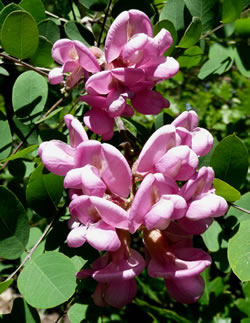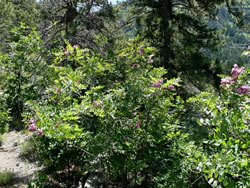Plant of the Week
 Range map of Robinia neomexicana. States are colored green where the species may be found.
Range map of Robinia neomexicana. States are colored green where the species may be found.
 The flowers of New Mexico locust make it instantly recognizable as a member of the pea family. Photo by Charlie McDonald.
The flowers of New Mexico locust make it instantly recognizable as a member of the pea family. Photo by Charlie McDonald.
 All of the locust trees have similar pinnately compound leaves. Photo by Charlie McDonald.
All of the locust trees have similar pinnately compound leaves. Photo by Charlie McDonald.
 This New Mexico locust is growing on a rocky ridge in the Sandia Mountain Wilderness of the Cibola National Forest east of Albuquerque, New Mexico. Photo by Charlie McDonald.
This New Mexico locust is growing on a rocky ridge in the Sandia Mountain Wilderness of the Cibola National Forest east of Albuquerque, New Mexico. Photo by Charlie McDonald.
New Mexico locust (Robinia neomexicana)
By Charlie McDonald
New Mexico locust (Robinia neomexicana) should have been called the southwestern locust because this small tree thrives in mountains throughout the southwestern United States. It grows along with Gambel oak (Quercus gambelii) as a prominent understory tree in spruce-fir, fir, and mixed conifer forests. It is often found in pure stands in forest openings and can dominate shortly after a fire because of its vigorous root sprouting.
New Mexico locust is in the genus Robinia,which is a small group of trees and shrubs in the pea family (Fabaceae). Black locust (Robinia pseudoacacia), a medium sized tree native to the eastern United States and now naturalized throughout North America, is the best known member of this group. Bristly locust (Robinia hispida), clammy locust (Robinia viscosa), and New Mexico locust are the other species in the genus. Actually, these three species are all quite similar. They are all shrubs or small trees with pendulous clusters of rose-pink pea-like flowers and they all have glandular hairs, bristles, or both on the twigs, leaf stalks, flower stalks, and fruit. They are all well protected with stiff stipular thorns on their stems.
New Mexico locust has beautiful flowers that can brighten whole hillsides in the spring so it is sometimes planted as an ornamental. This use, however, is limited because of its small size, tendency to root sprout, and thorny stems. The wood is hard, heavy, and durable, but trees seldom grow large enough to be sawed into lumber. The wood is sometimes used for items like tool handles, and for fence posts. Perhaps, though, the best thing about New Mexico locust is just that it is an easy to identify attractive little tree that adds color and diversity to our southwestern national forests.

